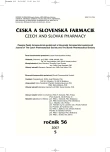-
Medical journals
- Career
Cytochrome P450 3A polymorphism and its importance in cyclosporine and tacrolimus therapy in transplanted patients
Authors: J. Ďuricová; M. Grundmann
Authors‘ workplace: Ostravská univerzita, Zdravotně-sociální fakulta, Ústav klinické farmakologie FN, Ostrava
Published in: Čes. slov. Farm., 2007; 56, 220-224
Category: Review Articles
Overview
The calcineurin inhibitors cyclosporine (CsA) and tacrolimus (Tac) are widely used in the prevention of acute rejection after solid organ transplantation. However, their clinical use is associated with many adverse reactions. The calcineurin inhibitors CsA and Tac have a narrow therapeutic index and show highly variable pharmacokinetics. The low CsA and Tac bioavailability has been attributed to interindividual differences in the expression of the metabolizing enzyme cytochrome P450 3A. The genes for CYP3A4 and 3A5 undergo genetic polymorphism. The results of many studies focusing on the impact of CYP 3A polymorphism on CsA and Tac pharmacokinetics are clear with Tac, where an association between CYP 3A polymorphism and the pharmacokinetic consequences has been shown. However, the results with CsA are controversial.
Key words:
CYP3A – polymorphism – cyclosporine – tacrolimus – transplantation
Labels
Pharmacy Clinical pharmacology
Article was published inCzech and Slovak Pharmacy

2007 Issue 5-
All articles in this issue
- Oxidative stress and its role in respiratory diseases
- Cytochrome P450 3A polymorphism and its importance in cyclosporine and tacrolimus therapy in transplanted patients
- Abiotic elicitation of Trifolium pratense L. Suspension culture
- Effect of vanadium compounds on the growth and production of coumarins in the suspension culture of Angelica archangelica L.
- Effect of thermal curing of the ethyl cellulose film on the rapidity of release of diclofenac sodium from pellets
- Mucoadhesive tablets for oral administration of ciclopiroxolamine
- Determination of valproic acid by on-line coupled capillary isotachophoresis with capillary zone electrophoresis with conductometric detection
- Czech and Slovak Pharmacy
- Journal archive
- Current issue
- Online only
- About the journal
Most read in this issue- Mucoadhesive tablets for oral administration of ciclopiroxolamine
- Oxidative stress and its role in respiratory diseases
- Cytochrome P450 3A polymorphism and its importance in cyclosporine and tacrolimus therapy in transplanted patients
- Determination of valproic acid by on-line coupled capillary isotachophoresis with capillary zone electrophoresis with conductometric detection
Login#ADS_BOTTOM_SCRIPTS#Forgotten passwordEnter the email address that you registered with. We will send you instructions on how to set a new password.
- Career

